February 15, 2019
Air Date: February 15, 2019
FULL SHOW
SEGMENTS

Senate Passes Bipartisan Public Lands Bill
View the page for this story
92 Senators recently voted to pass the most sweeping land conservation bill in a decade. The legislation designates 1.3 million new acres of wilderness, five new national monuments, and hundreds of miles of wild and scenic rivers. It also permanently authorizes the Land and Water Conservation Fund, which uses fees from offshore oil and gas drilling to conserve public lands. Democratic Senator Maria Cantwell of Washington state cosponsored the bill and spoke with host Bobby Bascomb about what got this rare bipartisan effort across the finish line. (10:35)
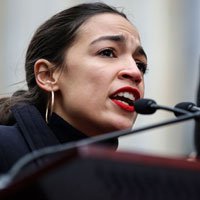
Understanding the Green New Deal
View the page for this story
Congresswoman Alexandria Ocasio-Cortez (D-NY) and Senator Ed Markey (D-MA) have released their outline for a Green New Deal, a piece of legislation intended to boost the economy while reducing greenhouse gases. Nathaniel Keohane, Senior Vice President for the Environmental Defense Fund, joins Host Bobby Bascomb to explore the Green New Deal draft and where the movement goes from here. (07:32)

Beyond The Headlines
/ Peter DykstraView the page for this story
In this week’s look beyond the headlines, Peter Dykstra and host Bobby Bascomb talk about conservative criticisms of the Green New Deal, and an Australian court decision that’s killed a new coal mine proposal. Then, they look back fifteen years to when the Pentagon, under President George W. Bush, commissioned a report looking at how climate change could cause severe global destabilization. (04:27)
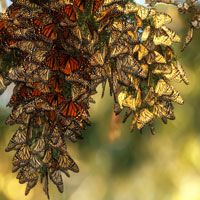
Monarch Butterflies Rebound
View the page for this story
Biologists are celebrating a promising year for eastern monarch butterflies, which overwinter in Mexico and whose population grew 144 percent from last year. But it’s a different story for the western monarch population, which spends the winter in California. Down to just 30,000 individuals, they’re on the edge of extinction. Tierra Curry, a Senior Scientist at the Center for Biological Diversity, talked to Bobby Bascomb about the monarch butterflies’ remarkable annual migration and what can be done to boost their numbers. (08:44)
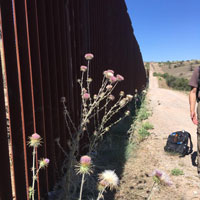
The Border Wall's Wildlife Impacts
View the page for this story
President Trump has declared a state of emergency to secure funding for a wall along the US border with Mexico. If built, the wall would disturb critical habitats and block migration routes for animals already stressed by climate change, and could possibly lead to extinction for some rare and endangered species. Biologist and Outdoors Coordinator for the Sierra Club Sergio Avila talks with Host Bobby Bascomb about the impacts of a wall on some rare species including jaguars and pygmy owls. (10:11)
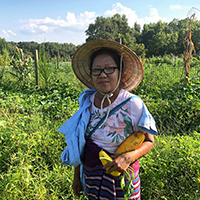
Refugees Cultivate Healing Through Gardening
/ Sean PowersView the page for this story
A community garden called the Neighbor's Field in rural Georgia helps refugees heal from the pain and trauma of war by planting a garden. Producer Sean Powers of Georgia Public Broadcasting and the Bitter Southerner podcast has the story. (04:43)
Show Credits and Funders
Show Transcript
HOSTS: Bobby Bascomb
GUESTS: Sergio Avila, Maria Cantwell, Tierra Curry, Nathaniel Keohane
REPORTERS: Peter Dykstra, Sean Powers
[THEME]
BASCOMB: From Public Radio International – this is Living On Earth.
[THEME]
BASCOMB: I’m Bobby Bascomb.
The Senate overwhelmingly passed the most sweeping land conservation bill in a decade.
CANTWELL: We came together around the Land and Water Conservation Fund. It had expired in September, and we were able to get a coalition of members on both sides of the aisle who believe in access to public lands, to fight for permanent reauthorization.
BASCOMB: Also, President Trump’s proposed border wall could have disastrous consequences for many animal species already stressed by climate change.
AVILA: So it's very important that we acknowledge that the border barriers are compounding the impacts of climate change by not allowing animals to move freely and to adapt and reach water or reach food or reach cooler places where they can survive.
BASCOMB: That and more this week on Living on Earth – Stick Around!
[NEWSBREAK MUSIC: Boards Of Canada “Zoetrope” from “In A Beautiful Place Out In The Country” (Warp Records 2000)]
[THEME]
Senate Passes Bipartisan Public Lands Bill
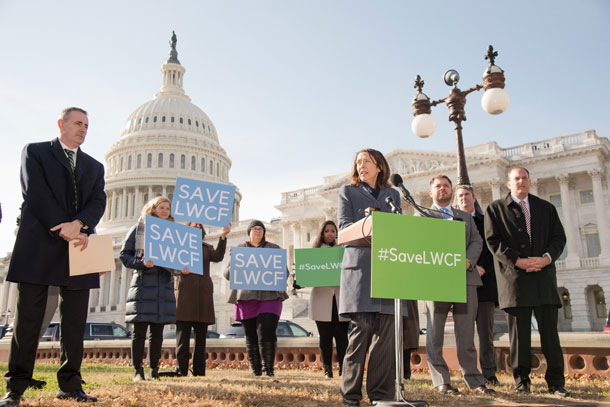
Senator Maria Cantwell spoke at a November 29, 2018 rally to save the Land and Water Conservation Fund, which Congress failed to reauthorize before its expiration on September 30th. (Photo: U.S. Senator Maria Cantwell)
BASCOMB: From PRI and the Jennifer and Ted Stanley Studios at the University of Massachusetts Boston, this is Living on Earth. I’m Bobby Bascomb, in for Steve Curwood.
In a rare bipartisan effort, the Senate has passed the most comprehensive conservation bill in a decade. The bill designates 1.3 million acres of new public land, five new national monuments, and hundreds of miles of wild and scenic rivers. It also permanently authorizes the Land and Water Conservation Fund, which uses fees from offshore oil and gas drilling to conserve public lands and water. Democratic Senator Maria Cantwell of Washington state cosponsored the bill and joins me now from Capitol Hill. Senator, welcome to Living on Earth!
CANTWELL: Thank you so much for having me on today.
BASCOMB: Senator Cantwell, I think congratulations are in order! You and your colleagues were able to pass a conservation bill, 92 to 8, in these highly partisan times. That seems like something of a miracle.
CANTWELL: Well, apparently Teddy Roosevelt's spirit is still alive and well in the United States Senate.
BASCOMB: [LAUGHS] I'd like to think so. What do you think got this bill over the finish line at a time when Washington seems so divided?
CANTWELL: Well, we came together around an important concept, which is the Land and Water Conservation Fund. It had expired in September, and members on both sides of the aisle thought that it was an important program that should be reauthorized. And we were able to get a coalition of members who believe in access to public land, to fight for a permanent reauthorization.
BASCOMB: Well let's unpack this a bit. What's in this bill in terms of additional protection for public lands?

The public lands package would add about 1.3 million acres of wilderness, including in New Mexico’s Organ Mountains. (Photo: Bob Wick / BLM California, Wikimedia Commons public domain)
CANTWELL: Well, the bill itself authorizes about 1.3 million new acres of wilderness. Those are in states like Utah and New Mexico and California. It creates more acreage of Wild and Scenic Rivers. And those are important tools to take some of the most pristine areas of our country and preserve them for continued access and recreational use. And then it also has mineral development withdrawals. For example, in my state of Washington, a very key recreation area called the Methow Valley, one of the most beautiful parts of our state, definitely didn't see itself consistent with mining and wanted the public lands withdrawn from mineral development. So those are the ways in which we can help local communities achieve their goals to have lands that are still pristine and accessible by so many people in the community.
BASCOMB: I understand that there's also a volcano early warning system involved here, which would affect you in your home state with Mount Rainier and Mount St. Helens. Can you tell me more about that?
CANTWELL: Yeah, the "Ring of Fire" that are these volcanoes across several states in the West, are real potential threats to us. We know that because of Mount St. Helens that blew up in 1980. So we want our scientists, our volcanologists to have the best information about these potential hazards. To do that, you actually need to have monitoring technology, and not all our volcanoes have that monitoring technology and they don't have real-time data for our geologists and scientists to evaluate. So this will make that investment in these areas. So whether you're in California, Oregon, Washington, Alaska, you will have that information.
BASCOMB: Can you tell me more please about what this bill provides in terms of preparing the nation for wildfire, especially in light of climate change and increasing wildfires in the future.
CANTWELL: Very good question. We have a wildfire management technology upgrade in this bill. Why? Because we're having so many more fire starts. We want the firefighters and their locations to be known at all times. And we want information about the fires to be real-time mapping. So we believe that pushing the Forest Service further on drone usage, as this bill will do, and a GPS system will literally give us situational awareness around the fires and fire starts. Once the firefighters are deployed and getting drone access, they literally can see where other fire starts are in the region. That real-time mapping is going to help us make firefighters safer. And it's also going to give us more data on where to deploy our resources. The second thing that it does, it's also going to use real-time technology information post-fire, to alert us on potential flooding. What happens after a fire, when so much vegetation is off of the land and rains come in, the impact of flooding can be quite significant, and mudslides. And what this real-time data from our NASA satellites will help us with is what are the immediate risks to those kinds of activities post-fire. And it also is putting resources into smoke forecasting. As we've seen in the last year, the amount of smoke now in our communities from fires as far away as Canada can impact communities greatly. And this gives additional resources for real-time information on smoke forecasting.
BASCOMB: Wow, well, they seem like really obvious and practical things to do.
CANTWELL: Well, that's what happens when you actually work together to pass legislation, you can get those things implemented. So we're very happy about that because we've definitely been impacted in the West and fire and we feel like the reason why we need to do public lands bills is because it's our job to manage that resource. And we want to use the latest and greatest technologies to help manage that resource. And so we feel that as climate does impact us across the United States, whether it is water, or fire, drought; we need to continue to upgrade our resources here federally to make sure that we are being good stewards of those lands.
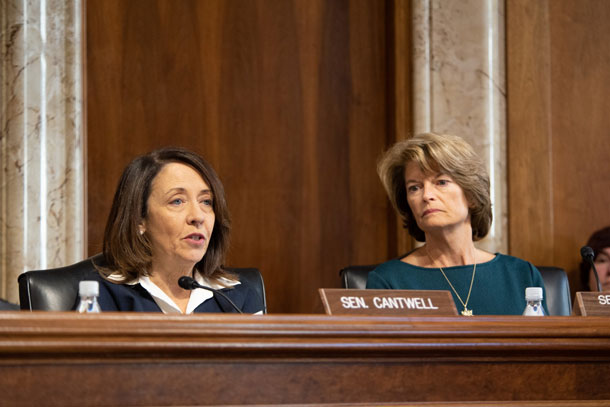
Senators Maria Cantwell, left, and Lisa Murkowski, right, cosponsored the public lands bill and serve together on the Committee on Energy and Natural Resources. Senator Murkowski, the senior Senator from Alaska, chairs the committee. (Photo: U.S. Senator Maria Cantwell)
BASCOMB: Well, I have to tell you, for those of us that watch these issues pretty closely, it came as a surprise that so many of your colleagues were willing to sign on to this bill and in such a bipartisan way agree with you that conservation is something that you need to take very seriously at this point.
CANTWELL: Well, I think what happened is, there were definitely the naysayers who did want to dismantle or change the Land and Water Conservation Fund. But I think for my Western colleagues, many of them have seen this debate play out in their own states, and you have a coalition of people who have come together, whether it's cattlemen and bow hunters and fishermen and recreationalists, all come together and say, "No, this is for the public. These lands are for the public, and we want them to be preserved for the public use." You know, we do think we're going to come back and have another debate about funding the backlog and maintenance in our national parks, because there are ways to improve access to those parks. And we think we'll probably have conversations about making sure that the money from LWCF oil and gas royalties really does get spent on public lands instead of just going into the coffers of the federal government. But one thing's clear: this effort of ours to say that public lands are big economic impact and big business -- the outdoor economy is now third behind finance and healthcare as the third biggest sector -- that not only helped us get those votes, but my guess is will help us get future investments in public lands too from a financial perspective.
BASCOMB: And now, this bill comes on the heels of President Trump shrinking two national monuments in Utah, Bears Ears and Grand Staircase-Escalante. Those shrank by about 2 million acres. And that decision was basically to allow for mining in federally protected lands. Is this bill a rebuke of that type of environmental rollback from the Trump administration?
CANTWELL: Well, I think it's definitely a repudiation that public land should be reverted back to oil and gas development. When you have mineral withdrawals, and you have wilderness designations, I think it's definitely saying that we believe in public lands for the benefit of the public as opposed to special interests.
BASCOMB: What are the bill's prospects, do you think, for moving through the House and then being signed into law by the President?
CANTWELL: Well, we think they're very good, because we've worked with our colleagues in the House -- Congressman Grijalva, who is now the chairman of the committee and Congressman Bishop, who was the chairman prior to the Democrats taking over, and they both enthusiastically support this bill. So we're hoping it'll have easy House passage and that will get onto the President's desk very soon.
BASCOMB: Why is this issue so important to you? Why spend so much of your time on wilderness and public lands?
CANTWELL: Well, to me, personally, I'm a hiker and outdoors person. And I can just tell you, it's such a rewarding experience. And I see this in my own state, for veterans, for young schoolchildren, for the elderly, even, to get out into the beauty of the outdoors is really almost a spiritual thing. And the fact that we can give the American people use of their land for the public benefit is just a fabulous thing.

The public lands bill would make Washington state’s Methow Valley off-limits to mining. (Photo: Photo Journal, Flickr CC BY-NC-ND 2.0)
BASCOMB: Before you go, let me ask you about the Green New Deal, which was recently introduced to Congress. What is your take on that?
CANTWELL: I have to see what the resolution says, but I'm enthusiastic about the focus of a Green New Deal. We've been able to do a couple of things in the last decade. That is, increase the fuel efficiency of automobiles. We've been able to build out a smarter electricity grid, which is helping us on efficiency of all our energy uses. And we've been able to put tax incentives in place to fund more renewable energy instead of fossil fuel energy. And I want to keep that accomplishment going. I want us to double down on that, if you will. So I look forward to seeing the details of the resolution. I think it is just going to be introduced as a resolution. So we'll see what all of the provisions say, but the enthusiasm for more investments in conserving fossil fuels and switching over to renewables is a very good focus.
BASCOMB: Senator Maria Cantwell has served as a Democratic Senator from Washington State since 2001. Senator Cantwell, thank you so much for this time with me.
CANTWELL: Thank you, Bobby.
Related links:
- The Washington Post | “The Senate just passed the decade’s biggest public lands package. Here’s what’s in it.”
- AP | “Senate backs major public lands, conservation bill”
- Read the full Senate Bill, the “Natural Resources Management Act”
[MUSIC: Bela Fleck & the Flecktones, “Flight Of the Cosmic Hippo” on Flight Of the Cosmic Hippo, by Bela Fleck/Howard Levy/Victor Wooten/Roy Wooten, Warner Brother]
BASCOMB: Coming up – Good news for butterflies! The population of Eastern Monarchs more than doubled last year. That’s just ahead on Living on Earth.
ANNOUNCER: Support for Living on Earth comes from Sailors for the Sea and Oceana. Helping boaters race clean, sail green and protect the seas they love. More information at sailors for the sea dot org.
[CUTAWAY MUSIC: Bela Fleck & the Flectones, “Flight Of the Cosmic Hippo (REPRISE),” on Flight Of the Cosmic Hippo, by Bela Fleck/Howard Levy/Victor Wooten/Roy Wooten, Warner Brothers]
Understanding the Green New Deal
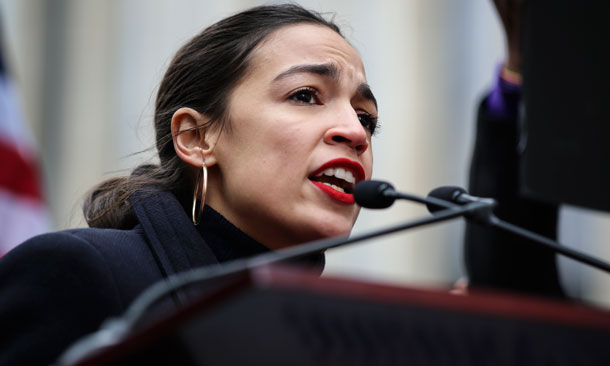
Alexandria Ocasio-Cortez has introduced a resolution for a Green New Deal, an environmentally-focused equivalent of the economy-boosting New Deal that President Franklin D. Roosevelt put into effect during the Great Depression. (Photo: Dimitri Rodriguez, Flickr, CC BY 2.0)
BASCOMB: It’s Living on Earth, I’m Bobby Bascomb.
In 1933 President Roosevelt enacted a massive government response to the Great Depression. The New Deal was a series of work programs and regulation reforms, that helped drag the United States out of the worst economic crisis in our nation’s history. Now congresswoman Alexandria Ocasio-Cortez, and Senator Ed Markey have released The Green New Deal in response to a crisis of a different kind – climate change. The resolution is an outline that seeks to create jobs while simultaneously reducing our biggest sources of greenhouse gas emissions. It’s an ambitious plan to make buildings more energy-efficient, build a high speed rail system, and reform agricultural production. It also calls for meeting 100% of our energy needs with zero carbon sources by 2030. Joining me to explain is Nathaniel Keohane. He’s Senior Vice President at the Environmental Defense Fund and says the goals of the Green New Deal are really two fold.
KEOHANE: Well, when I look at the Green New Deal resolution, I see two goals that really stand out. And one is having a longer term goal of getting to net zero emissions, hundred percent clean, across the entire economy, which I think if we look at the science, the science tells us that needs to be done by 2050. And as part of that, there's the more specific and immediate goal of getting to 100% clean in the power sector by 2030. I think those are both big and ambitious goals, and exactly the kind of goals we need. I think the power sector goal; that's achievable if we put the kind of investment in the kind of policies in place to meet it, and we need to make sure that we are drawing on every technology we can that’s going to get us there.
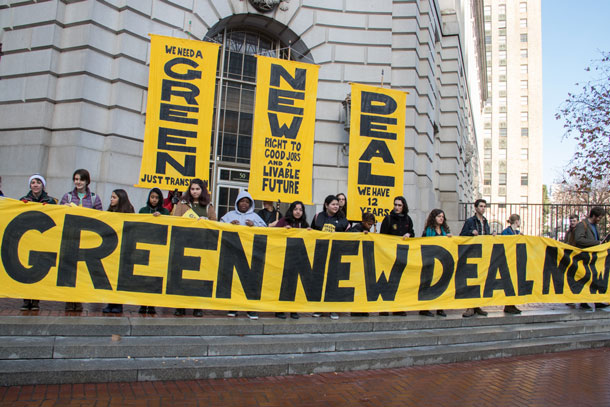
The Green New Deal is designed to revitalize the US economy through the creation of jobs and a movement away from fossil fuel industries. (Photo: Peg Hunter, Flickr, CC BY-NC 2.0)
BASCOMB: Do you think it's feasible then? Or is it sort of setting a very, very high goal with the hope that maybe you’ll get somewhere in the middle?
KEOHANE: I think that's a question that really depends on political will. It's certainly technologically feasible. But can we mobilize the political will not only in Congress, but in the States, and among all of us citizens, and among corporations, and so on, to make the investments to put the policies in place to make this switch? So that's what I think will determine whether it's feasible.
BASCOMB: Well, much like the original New Deal put forth by FDR, the Green New Deal hopes to create jobs with this, and there's a whole lot of social components to it. But how many jobs are there currently in renewable energy or carbon zero energy? And what do you think is the potential in the future for that, if we take this approach?
KEOHANE: We're already at a point where there are more “green jobs”, so to speak, in electric power. There are more jobs in renewable energy, and wind, and solar energy right now, than in fossil fuels. And in terms of electric generation. No discussion about economic prosperity is complete without thinking about the costs that we're paying right now of inaction. And so we have to recognize there is no high-carbon path to economic prosperity, because on our current course, the world we’ll see in the coming decades is not one that is a world of prosperity. It's one that is a world of increasing climate damages, and all that brings with it. So, if we're thinking about economic prosperity, jobs, growth, and inclusive growth, I think the climate agenda and that economic agenda are one and the same.
BASCOMB: Now, to what extent do you see the Green New Deal as having a place in the 2020 election?
KEOHANE: Well, I think you're already seeing many of the candidates, on the Democratic side at least, talk about it. And I think the fact that this has put climate at the top tier of issues that presidential candidates have to talk about; that is terrific, right? That is a terrific development. For many years, we've heard that people say climate is important issue, they care about it, you know, increasing numbers, think we need to do something about it, they're worried about it, but it hasn't risen to the top tier issue. Now, for the first time, we're starting to see it rise to that level. That's true in polling data. And I think that's also then true in terms of framing the political debate, as people see extreme weather events, as they see the impacts of climate change, they are connecting the dots, and they're making this a higher priority. And I think that's part of what we're seeing in the political debate as well.
BASCOMB: House Speaker Nancy Pelosi has basically indicated that she won’t introduce this resolution to the House floor. If the Green New Deal doesn't get any traction right now, what do you see as the most likely future for this plan?
KEOHANE: Where I see this, is we need as many ideas, as many proposals, from as many different voices, to be in this debate, and to be elevating the debate and adding energy to the debate and adding the chorus that says, this is a top tier issue for the country, that we need to solve for our sake, for our children sake, for our grandchildren sake, for this of the future prosperity and leadership of America. And so I'm less concerned, I guess, with where any one proposal or resolution or, or even, you know, legislative bill at this point ends up as we move forward. I think we need to be taking all the ideas we can and bringing them together in a way that can meet the level of urgency and ambition that the Green New Deal resolution so clearly articulates and meet that in a way that is durable, that achieves broad support in Congress, so that we have those policies not just for a year or two years, but they stand the test of time. We need long-term deep structural policies, as well as government investment and all the rest. And so, to do that, we're going to need to get ideas from as widely as we can on the political spectrum, and then put them together in something that can pass the Congress with a durable political support.
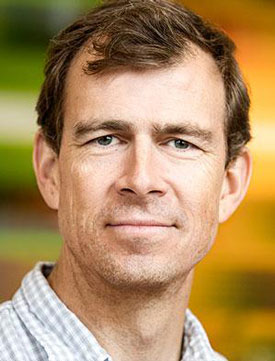
Nathaniel Keohane is the Senior Vice President for Climate at the Environmental Defense Fund. (Photo: Courtesy of the Environmental Defense Fund)
BASCOMB: Well, there's a lot in here. I mean, there's a lot of different proposals, they're looking at energy efficiency in buildings, and transportation, and agriculture. But, of everything you've read, in the Green New Deal, what do you think is the most promising or maybe could put the biggest dent into this problem that we have?
KEOHANE: I think about this a little bit differently than the way it's laid out in the Green New Deal. And here's what I mean by that. I think we need to set our eyes on the most ambitious goals we can meet. The 14 areas that the Green New Deal identifies: transport, agriculture, landowners, power sector, industry, energy efficiency, those are all going to be part of the solution. But the way I look at it is; what we really need to do, from a policy point of view, is create the broad based systematic incentives that mobilize everybody in the economy to be finding solutions that reward everybody in the economy - businesses, entrepreneurs, innovators, individuals - to find the ways they're going to cut climate pollution and reward them for figuring out better and cheaper and faster ways of doing it and taking it out of the sky. That’s the way that we're going to get as fast and far as we can, and that we're going to mobilize the whole economy to do it. There is a critical role for government in setting those policies out. What we need to do is put in place the broad based incentives that will mobilize the entire economy and all the American people into finding those solutions.
BASCOMB: Nathaniel Keohane is Senior Vice President at the Environmental Defense Fund. Nat, thanks so much for taking the time with me.
KEOHANE: Thanks very much for having me on.
BASCOMB: Senate majority leader Mitch McConnell has said he will soon call a vote on the Green New Deal. It’s not expected to pass in the Republican controlled Senate and will force a vote from Democrats who have not yet voiced an opinion on the resolution.
Related links:
- Read the full text of the introduced Green New Deal resolution
- CNN | “Here’s What the Green New Deal Actually Says”
- EDF | “EDF: Green New Deal Resolution Is an Important Step Forward in the Climate Debate”
[MUSIC: Ed Mann & Brian Hand, “Bell Garden” on Global Warming, by Ed Mann & Brian Hand, Interworld Music]
Beyond The Headlines
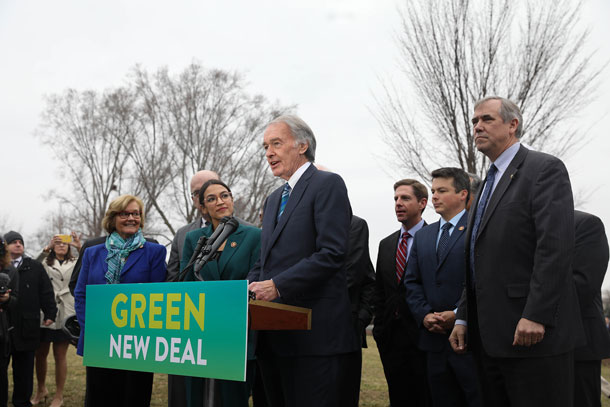
Senator Ed Markey (D-MA), center, spoke at a February 7, 2019 press conference about the Green New Deal, flanked by his cosponsor Rep. Alexandria Ocasio-Cortez (D-NY). (Photo: Senate Democrats, Wikimedia Commons CC BY 2.0)
BASCOMB: It's time for a trip now beyond the headlines with Peter Dykstra. Peter's an editor with Environmental Health News -- that's ehn.org -- and DailyClimate.org. Hey there Peter, what do you have for us this week?
DYKSTRA: Hi Bobby. Well, I'm going to put on my Washington, DC know-it-all, blowhard TV pundit hat, and make a little political prediction. The Green New Deal is poised to become a centerpiece of rhetoric that climate and green energy are part of a sinister effort to take over America, and then take over the world!
BASCOMB: And what evidence do we have of that?
DYKSTRA: Well, it's bubbling up in a lot of, well, let's call them the right-wing mainstream sites and pundits, people like Hugh Hewitt, the radio talk show host, and blogger who said this about the Green New Deal -- quote -- "It is not socialism, it is Communism, it is fascism, it is despotism." And then Sean Hannity, who of course has been recognized as one of Trump's closest advisors, said on Fox News that the Green New Deal is, quote, "one of the most dangerous, impractical, misguided, economically guaranteed to be devastating plans ever championed by any American politician." And finally, on Fox and Friends, Brian Kilmeade said this: the Green New Deal look like it was put together by a 10th grader, whereupon one of the Fox and Friends guests talked him down to agreeing that it was put out by a third grader.
BASCOMB: Wow, strong words. But, for those Republican legislators who do think climate change is an urgent issue, do you think maybe the Green New Deal puts pressure on them to come up with a better idea, something more in line with their conservative thinking?
DYKSTRA: Well, it only puts pressure on people who accept climate change as not only a fact, but a fact that will affect our lives and economy and ecology in the coming years. And of course, not all conservatives are there by any means -- not in Congress, not in the Cabinet, not in the White House with the President himself. The advocates of the Green New Deal have to be realistic that when they push what many Americans view as essential, common sense, other Americans are going to perceive it as a threat. And they're going to be encouraged to do so.
BASCOMB: Right. But I mean, climate change, it's sort of like gravity, you know; believe in it or not, it's still going to affect you. You know, if you walk off a cliff, you're going to fall.
DYKSTRA: Uh, yeah, but Congress is a place where laws are made, but the law of gravity doesn't always fit into the logic of how Congress works. Think of the original New Deal, as put together by Franklin Delano Roosevelt. It was a fix for the Great Depression. Everybody accepted that the Great Depression was real and was having an impact in every corner of America. Whether we should be there or not, despite all the warnings, we're not there with climate change politically.
BASCOMB: Well, what else do you have for us this week, Peter?

The Anglesea coal mine in Victoria, Australia. The nation is the world’s leading exporter of coal. (Photo: Takver, Flickr CC BY-SA 2.0)
DYKSTRA: Australia is one of the coal happiest nations on Earth; they still get nearly two-thirds of their electricity from coal. And they're the world's leading exporter of coal, particularly to growing economic powers in Asia, like China and India. But here's a first from Australia's judicial system: a state court in New South Wales dealt a blow to a new coal mine project by citing the urgency to cut greenhouse gases instead of adding to the total; they killed a new coal mine proposal.
BASCOMB: Mmm. Well, perhaps unlike the United States, the average Australian might be accepting climate change more readily. I mean, they had just crazy wildfires this year in Tasmania and record high temperatures. We reported on that a couple weeks ago. It seems like maybe it's hard to ignore there.
DYKSTRA: Right; this January, the month we just concluded, was the hottest month ever on record in Australia.
BASCOMB: Well, what do you have for us from the history vault this week?

Fifteen years ago, when Donald Rumsfeld was Secretary of State, the Pentagon commissioned a report on how climate change could cause global upheaval, environmental refugees, devastating storms, and more. (Photo: David B. Gleason, Wikimedia Commons, CC BY-SA 2.0)
DYKSTRA: You know, there's some folks that look upon the Green New Deal as a mad power grab, like we said; but consider this: February's the 15th anniversary of a report commissioned by the Pentagon, at a time when the Pentagon was run by Secretary of Defense Donald Rumsfeld, "Mr. Iraq", that climate change could cause global upheaval, environmental refugees, flooded coastlines, devastating storms, and more. All of this foreseen by those dangerous radicals at the Pentagon.
BASCOMB: Well, thanks for that, Peter! Peter Dykstra is an editor with Environmental Health News, that's ehn.org, and DailyClimate.org. We'll talk to you again soon.
DYKSTRA: All right, thanks a lot, Bobby, talk to you soon.
BASCOMB: And there's more on these stories on our website, loe dot org.
Related links:
- Right-wing media takes on the Green New Deal
- Nature | “Landmark Australian ruling rejects coal mine over global warming”
- About Australia’s dependency on coal for electricity production
- Australia is on track for 50% renewable electricity by 2025
- About the Pentagon climate report commissioned in 2004
[MUSIC: Ed Mann & Brian Hand, “Vibes” on Global Warming, by Ed Mann & Brian Hand, Interworld Music]
Monarch Butterflies Rebound
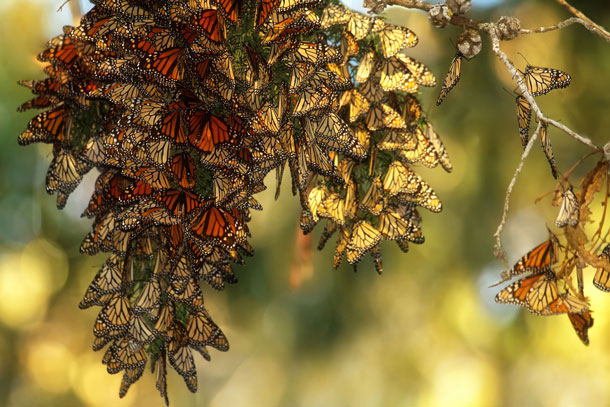
Monarch butterflies from west of the Rocky Mountains cluster amongst trees in Pismo Beach, California. (Photo: Sandy Chuck Harris, Flickr, CC BY-NC 2.0)
BASCOMB: Each year monarch butterflies travel from as far away as Canada to spend the winter in Mexico. The world’s entire population of Eastern Monarchs cluster together on just a few acres of a forest in the Sierra Madre mountains. That dense congregation makes the species vulnerable to predation and extreme weather. But it also makes it easy for biologists to count them and get an estimate of their numbers. And this year there was good news! There were more than twice as many Eastern Monarchs in 2018 compared with the previous year. But the news wasn’t good for Western Monarchs, which spend their winters in California. Here to explain is Tierra Curry, a senior scientist from the Center for Biological Diversity. She joins us from Portland, Oregon. Welcome back to Living on Earth!
CURRY: Thanks so much. It's great to be here.
BASCOMB: First, can you tell me a little bit about the incredible generational migration that monarchs undertake each year?
CURRY: Absolutely. Monarchs are amazing, and one of the most amazing things about them is they do this multi-generational migration. So we'll start at the end of summer. At the end of summer, monarch butterflies in the northern United States and southern Canada, wake up and go, “Oh, my gosh, I need to go to Mexico.” And they've never been to Mexico, and somehow, this generation, which is the great, great, great grandchildren of the monarchs that were in Mexico fly all the way back to the mountains of central Mexico to overwinter. So that's the super generation of monarchs. And they live for nine months, they overwinter, and then in the spring, they fly north from the sanctuaries in Mexico to Texas and the southern United States. They lay eggs and die. When those eggs become caterpillars that become butterflies, they only live a couple weeks, and they fly north again. And so there's three or four successive generations over summer till you get back to the super generation that overwinters.
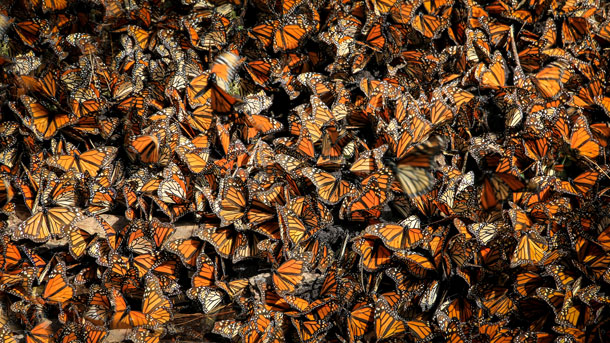
Monarch butterflies cover oyamel fir trees while overwintering in Michoacan, Mexico. They undertake an incredible migration of 3,000 miles or more to protect themselves from winter in the North. (Photo: Alex Guillaume on Unsplash)
BASCOMB: And when that third or fourth generation of Eastern monarchs, they finally make it to Mexico, they have a very specific area where they can spend the winter. Can you tell me about that please?
CURRY: They do. They go to 12 mountain tops between the city of Morelia and Mexico City. And it's above 10,000 feet, it’s oyamel fir forest and they cluster super densely on the trees. And they're supposed to chill out while they're there, they're supposed to save their energy and fat reserves so that they can fly north again in the spring. But, if it's unseasonably warm or if tourists disturb them, then they wake up and fly around too much and they might burn off their lipid supplies and they would have a decreased success of making it north again. So that's why they go there. It's not too hot, not too cold, it's the perfect place for them to overwinter.
BASCOMB: Like Goldilocks, it's just right.
CURRY: Right, exactly.
BASCOMB: So those are the eastern monarchs that spend their winters in Mexico, and how are they doing this year?
CURRY: They're doing great this year. It's such good news, there are six hectares of monarch butterflies in Mexico this winter. And that's up 140% from last year. And most importantly, that's just above the threshold that scientists say they need to be at to not be in danger of quasi-extinction or migratory collapse. So for this one good year, due to great weather, they’re right above the danger zone.
BASCOMB: So that's the eastern monarchs. But there are also a population of western monarchs, what's the difference between them?
CURRY: So genetically, they’re similar, and there is some interbreeding between them. Roughly, all the monarchs east of the Rocky Mountains go to Mexico for the winter; the monarchs west of the Rocky Mountains overwinter on the coast of California. And unfortunately, they had a terrible year. There are only 30,000 total Western monarchs this winter. And kind of the opposite of what happened with the eastern population --30,000 is at the threshold to be not recoverable. It's the quasi-extinction threshold identified in population modeling.
BASCOMB: And what were their populations like, say, 20, 30, 40 years ago, as compared to today?
CURRY: So historically, there would have been millions of Western monarchs. The scientists started counting them in 1997, the Xerces society started counting them, and in 1997, there were 1.2 million. And so this count is 30,000.
BASCOMB: Wow. What kind of protections are there in place for monarchs right now?
CURRY: None. Zero. I got an email this morning from somebody who has like a wetland with a bunch of milkweed that's going to be developed. And they wanted to know if having monarchs there could protect it, and the answer is no. But back in 2014, the Center for Biological Diversity and our allies petitioned for Endangered Species Act protection for monarchs and that decision has to be issued by the US Fish and Wildlife Service by the end of June this year.
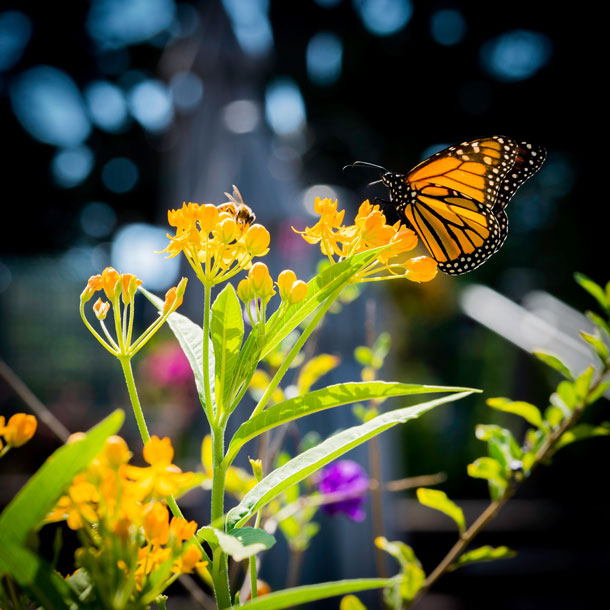
Monarch butterflies' main food source is milkweed. (Photo: Ryan Carpenter on Unsplash)
BASCOMB: And how would it change their fate if they do get that protection?
CURRY: It would help them in so many ways; one, their habitat would be protected. So it wouldn’t, you couldn’t cut down their overwintering trees. Like in California, their overwintering trees can still be cut down for development, and that would end. And then it would also lead to a recovery plan that would outline all the steps that are needed to boost the population and keep it above the six hectares of covered forest habitat.
BASCOMB: Talk to me a bit about monarchs and the role that they play in the ecosystem. Why are they important ecologically?
CURRY: They're important ecologically because, well, when there were billions of them, they would have played a very big role in the food web. And they still provide food for other species as eggs, as caterpillars, and as adults. We just have to have enough monarchs for all the animals that want to eat them to be able to eat them, because predation is natural. So that's why there has to be millions and billions of monarchs.
BASCOMB: Now, what about the cultural significance of monarchs, especially in Mexico, where they just descend on this one small area, what do the people there think of them?
CURRY: In Mexican folklore, the monarchs represent the departed souls of loved ones, because they usually get back to Mexico in time for the Day of the Dead celebrations, like, that's when they arrive. And so they symbolize the departed souls of loved ones. And it's interesting, because in Mexico, monarchs represent fall and winter. But in the United States and Canada, monarchs are a symbol of summer and playing outside and seeing them in your garden.
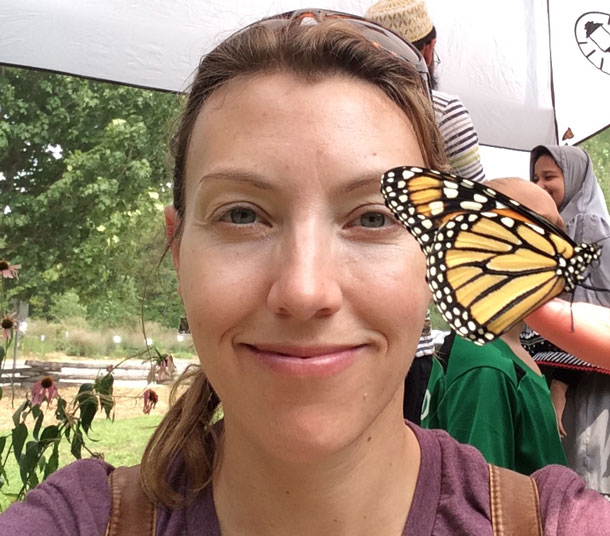
Tierra Curry, Senior Scientist at the Center for Biological Diversity. (Photo: Courtesy of Tierra Curry)
BASCOMB: Yeah, yeah, exactly. I mean, I remember as a kid, a friend’s mom used to bring them to school in a big pickle jar, you know, and you’d get to watch them change and go through their metamorphosis. And this past summer, I actually raised some with my own daughter.
CURRY: Oh, that's great.
BASCOMB: Yeah, it was really, really fun, actually. But is that actually a useful thing for people to do to raise them inside? Does it help them at all to, you know, not get picked off by a bird? Or is it just for our own benefit to have this neat thing?
CURRY: It's really for our own benefit. So many people have had that same experience, and raised monarchs in classrooms and in their home. And I think that's why people love them so much, and why people are willing to plant milkweed now and to eat organic corn and soy products to help them. But we're not going to save the monarchs by bringing them inside. And then there's this parasite called OE that can be really harmful to monarchs. It can cause them not to develop properly, to be underweight, or even to die, they might not make it through metamorphosis. And so if people bring in too many monarchs, and they don't between seasons bleach out their cages, then they can cause the parasite to do in the caterpillars that they're trying to raise. And especially what people shouldn't do is go to wild areas, and get those caterpillars and take them in their house. Like if you have the milkweed in your yard, and, you know a bird’s gonna eat the caterpillar, save its life. But don't go kidnap them from the wild.
BASCOMB: So what should a listener do if you're concerned about monarchs, and you have this, you know, relationship with them. What can we do?
CURRY: Plant milkweed, but milkweed that's native to the area where you live. There's, tropical milkweed is bad. It's pretty and it's easy to grow, but it's not native to the United States. And it doesn't die back in the fall, especially in warm areas. And so it just confuses the monarchs. So make sure that you plant native milkweed. And if it's still up at the end of fall, cut it down. One of the biggest threats to the monarchs is pesticides and insecticides. And so by growing or buying organic corn and soy products, in particular, because all of the habitat that has been turned over to genetically modified corn and soy that is treated heavily with herbicide has wiped out milkweed. So by buying organic corn and soy products, it supports the organic industry, which doesn't use those pesticides that hurt monarchs and other pollinators. And the US Fish and Wildlife Service is deciding right now whether or not to protect monarchs under the Endangered Species Act so people can write the US Fish and Wildlife Service and say, Please protect the monarchs as an endangered species so that they'll have a recovery plan and funding so that our kids and our grandkids will get to see the monarch butterflies.
BASCOMB: Yeah, raise them in those pickle jars, maybe.
CURRY: Yeah [LAUGHS]
BASCOMB: Tierra Curry is a senior scientist with the Center for Biological Diversity. Tierra, thanks for talking.
CURRY: Thanks for talking about monarchs.
Related links:
- The Center for Biological Diversity's Petition to Protect the Monarch Butterfly
- Center for Biological Diversity Press Release: Annual Monarch Count Shows Butterfly Still Threatened
- Center for Biological Diversity: Saving the Monarch Butterfly
[MUSIC: Libana, “Treeplanter’s Round” on Fire Within, by Dorothy Attneave Jackson, Ladyslipper Records]
BASCOMB: Coming up – Political refugees from Myanmar seeking solace at a community garden in Georgia. That’s just ahead on Living on Earth.
ANNOUNCER: Funding for Living on Earth comes from you, our listeners, and United Technologies, combining passion for science with engineering to create solutions designed for sustainability in aerospace, building industries, and food refrigeration. UTC companies such as Otis, Carrier, Pratt and Whitney, and UTC Aerospace systems are helping to move the world forward. You can learn more about United Technologies by tuning into the Race to Nine Billion podcast; listen at racetoninebillion.com. This is PRI, Public Radio International.
[CUTAWAY MUSIC: Joshua Messick/Ryan Knott/Zack Page/James Kylen, “Mountain Laurel” on Woodland Dance, by Joshua Messick, self-published
https://www.youtube.com/watch?v=CfGqb7wZxVg]
The Border Wall's Wildlife Impacts
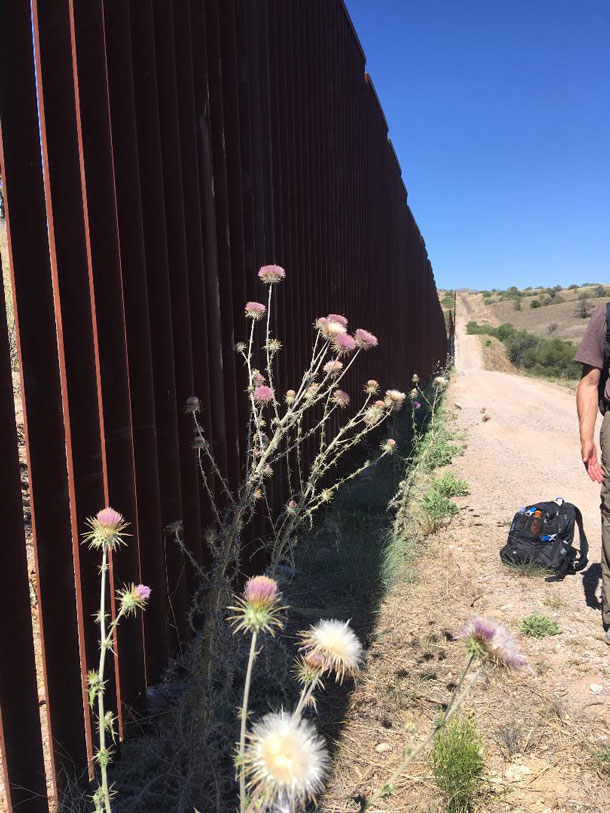
The border wall between the United States and Mexico causes various forms of damage to species native to the surrounding areas. (Photo: Courtesy of Sergio Avila)
BASCOMB: It’s Living on Earth, I’m Bobby Bascomb.
[BIRD SOUNDS]
The dawn chorus at the National Butterfly Center near the Rio Grande in Texas welcomes visitors each morning.
[BIRD SOUNDS]
The private nature reserve is home to more than 200 species of butterflies and endangered species, including ocelots and jaguarundis.
The Butterfly Center is just one example of the many critical habitats in the path of the proposed border wall. A Federal Appeals court in California ruled that the Trump administration is within its rights to disregard dozens of environmental laws to fast track the wall. And the Supreme Court has declined to hear a challenge from environmental groups. The wall would be nearly a thousand miles long and pass through critical wildlife habitat. Sergio Avila is a biologist and Outdoors Coordinator for the Sierra Club in the Southwest and joins me now. Sergio, welcome to Living on Earth!
AVILA: Thank you, Bobby. Glad to be here.
BASCOMB: Now, you've spent quite a lot of time in the border area. I know it's not a homogenous landscape, of course, but if you could please choose one of your favorite spots there and describe it for someone who's never been.
AVILA: Ah, yes. This is a great, beautiful region with rivers and valleys and mountains and deserts. For example, the Sonoran Desert is one of my favorite ones. The Sonoran Desert is defined by the saguaros, those iconic cacti that have big arms. And you can see a forest of saguaros when you stand on a hill. And you can imagine a long valley with mountains on the sides and these saguaros standing out there. Some of these plants are ancient. They were there when the Spanish first got to North America. They have seen the changes in the seasons, the changes in the people, the development in the desert. These saguaros have provided the life not only for birds but also for local communities whose culture is very closely associated to saguaros. We also have other types of cacti with beautiful red and pink and orange and yellow flowers that are super, super conspicuous during the spring. Right now, after the winter rains, the Sonoran Desert has a carpet of poppies. So you can go to some hills and just see orange all over and it's buzzing with bees and hummingbirds. So this is one of my favorite places along the border, the Sonoran Desert.
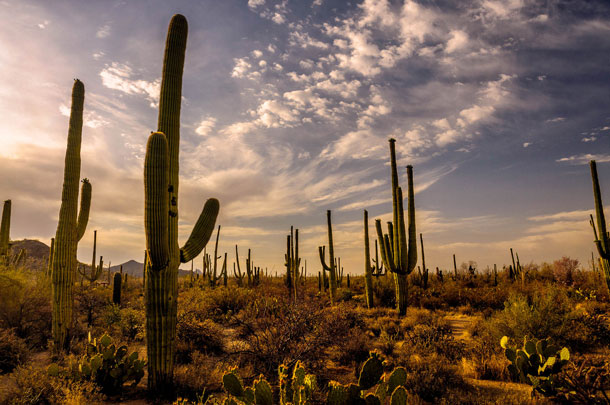
Saguaro Cacti are one of the defining species of the Sonoran Desert. (Photo: Ade Russell, Flickr CC BY-NC-ND 2.0)
BASCOMB: A wall both takes up space, which is an important habitat for animals, but it also blocks the migration path for many migrating species. Is that right?
AVILA: That is right. Blocking the migration prevents species from doing their normal life cycle. It's very clear that nature has no borders. All of these plants and animals and places that I have described exist in this region regardless of the borders, regardless of the political boundaries and straight lines that humans like to set. So all of these animals are blocked in their day to day activities or in their wide-ranging, looking for new territories. Specifically for jaguars. Jaguars are the third largest species of cat in the world, right after Siberian tigers and African lions. So, that is a big spotted orange and black cat that lives not only in the jungles of the Amazon but also in the Borderlands of Arizona and New Mexico. And we have records of these cats living up in the Grand Canyon in the beginning of the 1900s. So this is not just like an individual occurrence, this is part of their territory. This is part of their distribution range. And I have to say that it doesn't matter if these jaguars are north or south of the border. They are still blocked. They cannot reach food, they cannot reach water and they cannot reach mates for the future generations.
BASCOMB: Wow. It's pretty amazing, one animal that can live both in the Amazon rainforest and the Grand Canyon, which is very dry.
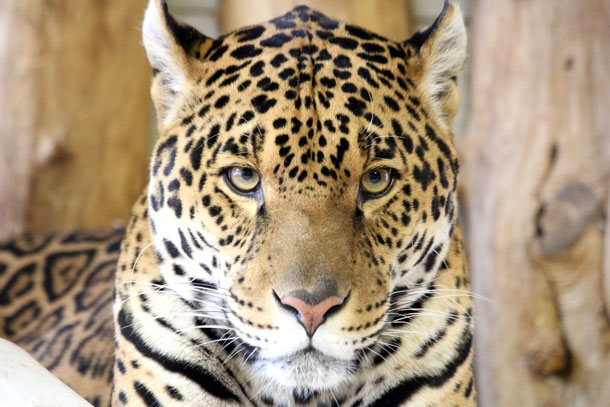
One of the species impacted by border walls is the jaguar, whose native range is anywhere between the Amazon rainforest and the Grand Canyon. (Photo: a_wilson, Flickr CC BY-NC-ND 2.0)
AVILA: And, in fact, one of the impacts that we have to address in regards to border walls and all this infrastructure is that also some of these animals are trying to move in a way to adapt to climate change. So some of these animals might be moving from warmer areas to cooler areas. Either from going from the south to the north, or from lower elevation to higher elevation areas. And so it's very important that we acknowledge that the border barriers are compounding the impacts of climate change by not allowing animals to move freely and to adapt and reach water or reach food or reach cooler places where they can survive.
BASCOMB: I understand even some bird species could have a hard time with the wall. Can you tell me please about the cactus pygmy owl?
AVILA: Absolutely! It's really good to address birds and species that many people think will not be impacted but, one example in the desert is the roadrunner, which many people know from the cartoons. I have to say the real one is a little smaller, it flies but it doesn't fly that high. So we have seen roadrunners just going back and forth in the border wall because they can't cross it. And that's very sad to see. And the same thing with the cactus ferruginous pygmy owl. Pygmy owls are tiny little owls, about five to six inches tall, that have very short flights. And they need to swoop, so they use a perch, like let's say they're sticking out their head out of the cavity in a saguaro, they need to swoop down and fly very low until they reach another place where they can perch or stand. And so if that area where they fly is blocked by a border wall the owls won't be able to fly over it. And that's not only pygmy owls but also elf owls and possibly even great horned owls.
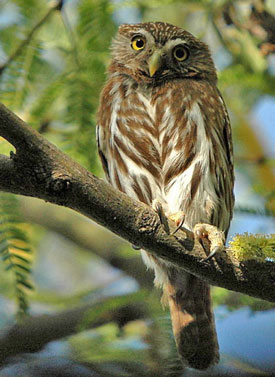
The Cactus Ferruginous Pygmy Owl is a low-flying owl that has a flight pattern that cannot clear barriers like border walls. (Photo: Wikimedia Commons Public Domain)
BASCOMB: Now some fish, as well, won't have full access to the rivers they need. Can you tell me about that, please? How fish might be impacted?
AVILA: Yes, I can say about a specific case in the San Bernardino National Wildlife Refuge, where this very small area of public lands has been protected to protect the last numbers of a couple of species of desert fish. This is what we call an endemic species. It's a species that only lives in one place. And, by creating a National Wildlife Refuge the Fish and Wildlife Service is protecting the water and the water quality and the habitat that those fish enjoy in that area. What has happened now with the border and heightened law enforcement is that there's a lot of erosion, they have deviated a little bit of the creek where these fish live by blocking water. The Department of Homeland Security has created flooding that has contaminated the habitat of these fish. They also contaminated the habitat by pouring concrete inside of the creek where these fish live. And it is crazy, not only for the life of these fish but imagine for the efforts that government and non-government agencies have put in a region that is so rich biologically. So yes, it is damageful in the habitat for the fish, but it's also a lot of damage in the local work and in years of outreach and education that a lot of these public officials have conducted down here.
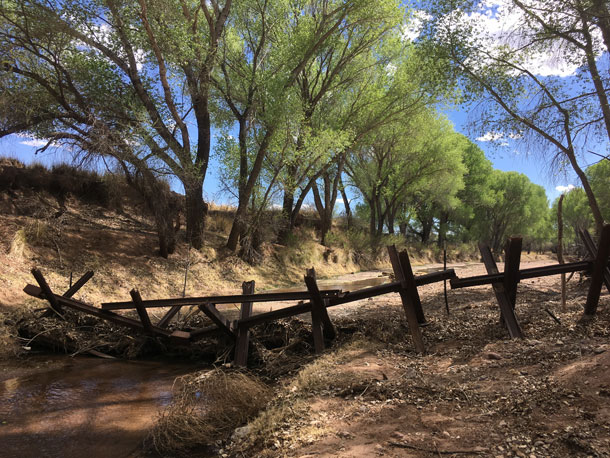
Even waterways are being blocked by border barriers, affecting native aquatic species. (Photo: Courtesy of Sergio Avila)
BASCOMB: Of the many many species that are potentially impacted by a wall, which one concerns you most if you can narrow it down?
AVILA: As a biologist, it's very difficult to disconnect one species from the rest. Because it would be very unfair for me; I'm a jaguar biologist so I'm concerned about jaguars, but if there's no deer, the Jaguars won't have anything to eat. I am concerned about the whole environmental impact in nature; everything's connected, so if we take one of the small pieces in the puzzle, all of the puzzle suffers. It's a big network. But it hurts me for bighorn sheep in the mountains of California. It hurts me for pronghorn antelope in the deserts of Arizona. It hurts to know that there is an ancient herd of bison in the Chihuahuan Desert that goes back and forth in New Mexico and Chihuahua and they are now blocked. Bison play such an important role not only in the ecosystem but in the cultures of people who have lived in these places for so long. It hurts me for the butterflies at the National Butterfly Center who are traveling from Canada to Mexico and don't find this rest area anymore. And it hurts me for all the human populations that enjoy these public lands, that enjoy national parks, that learn about their connection to nature. It hurts me for all the lost opportunities that are happening because of this.
BASCOMB: How likely is it, do you think, that some endangered species might actually go extinct as a result of a proposed border wall?
AVILA: I think it's likely. I think it's likely, and I think it's very sad because we're seeing it with our own eyes. And the solution is in our hands and yet, humans are not stepping up to do enough about that.
BASCOMB: For somebody listening to this, myself included, that's just feeling terribly depressed right now. I mean, these are iconic species, they're rare, they're endemic, you know, this wall is potentially so destructive. I mean, can you leave us on a positive note at all? Is there anything to be done for, you know, somebody that's listening to this and cares about this issue?
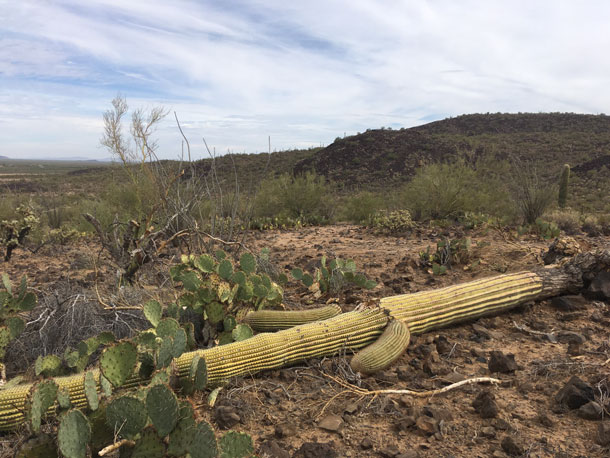
Damage due to the construction of a border wall has great impacts on species like the saguaro cactus, which is home to many other native species in their ecosystem. (Photo: Courtesy of Sergio Avila)
AVILA: Absolutely! In spite of all these challenges, political challenges, and social challenges, people need to know the Mexican gray wolves, that jaguars, that ocelots exist out there. That they are prevailing in spite of all this infrastructure. That animals are adapting to climate change, that water is still running in those rivers. And, so, with all those images, that saguaros are still standing in the summer and desert; if we keep those images alive and we know that those species are there, let's grab that hope and that energy to share our voice and speak on behalf of them.
BASCOMB: Sergio Avila is a biologist and outdoor coordinator with Sierra Club. Thank you so much for taking this time with me today.
AVILA: Thank you so much.
Related links:
- More about Sergio Avila
- The National Butterfly Center
- More about the cactus ferruginous pygmy owl
[MUSIC: Tim Gartland, “When the Next Wind Blows”]
Refugees Cultivate Healing Through Gardening
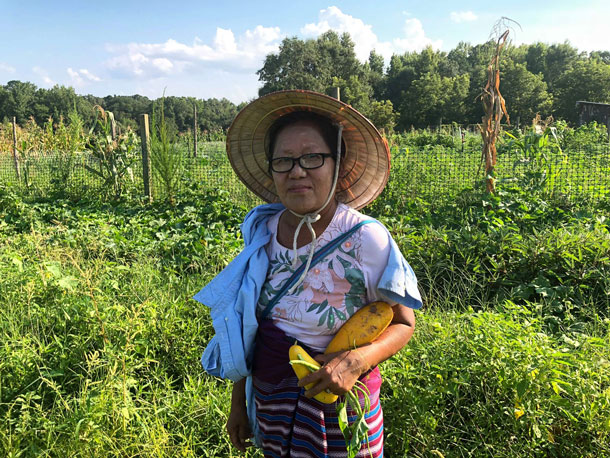
Moo Paw shows the vegetables she's grown at the Neighbor's Field. (Photo: Sean Powers)
BASCOMB: The United States has long been a place for political refugees to seek safety and put down roots, in some cases literally. In Comer, Georgia a community garden called the Neighbor’s Field is helping refugees work through their trauma by working the land. Producer Sean Powers has our story.
[ROOSTER SOUNDS]
POWERS: It’s a hot Saturday afternoon in Comer, Georgia. Moo Paw is feeding her chickens, hens, goats, and ducks. There’s even a donkey. You could say they’re kind of like her babies. She is one of the many refugees at the Neighbor’s Field, who fled violence and persecution in Myanmar. That’s the country formerly known as Burma.
[PAW SPEAKING IN BURMESE]
POWERS: Moo Paw tells me about her life before coming to the United States. She grew up in Myanmar and recalls living in fear of the Burmese soldiers. She says they would force her family to carry food and other supplies. Gardening at the Neighbor’s Field, she says, provides some relief from those painful memories.
MOO PAW: Gardening here, me forget the war. Me forget the war. Sometimes, me remember my father, how my father go to the Burma soldiers, kicked pappa…
POWERS: She says Burmese soldiers kidnapped her father, and used him as a porter to carry food for them. After leaving Myanmar, Moo Paw lived in a refugee camp in Thailand before moving to the United States with her husband and children. They relocated to the Atlanta area, before settling here in Comer. Her son, Tahay Than, says moving to Comer was to satisfy Moo Paw’s green thumb.
TAHAY: My mom, where she lived in Burma or Thailand, she always liked to plant. You know, working the farm. So, when she farms, that makes her feel like she is home or something, like in a home country, mother country or something. So that’s why she moved to Comer.
POWERS: The Neighbor’s Field is a place of healing for Moo Paw. She comes here twice a day, except Sundays. Sundays, of course, are for church. She shows me around the garden.
PAW: My garden. Here vegetables. Here grass. Me planted the cucumbers this year. Here sweet potato. Very beautiful.
POWERS: It’s that beauty that takes Moo Paw back to memories of her family. She and her son Tahay say in Myanmar, farming for their family was a way of life.
PAW: My grandmother planted rice, peanuts. Chili, corn.
TAHAY: Most of the time, everybody who lived in Burma, they would plant in order to survive.
POWERS: And that makes this garden all the more meaningful. The vegetables growing here, they don’t look like your typical produce that you would find at most supermarkets in the United States. That’s because the seeds come from Myanmar and Thailand. With us on our garden tour is Rebecca Smith. She oversees the day-to-day operations at the Neighbor’s Field. As we chat we spot a pumpkin from Thailand.
SMITH: It’s green, kind of stripy green and light yellow. How do you cook this, Moo Paw?
PAW: Garlic, onions, a little chicken.
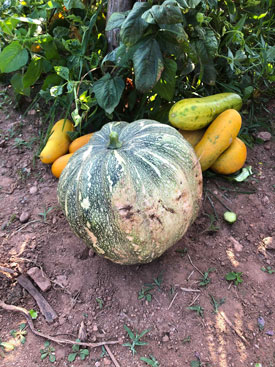
Much of the produce at the Neighbor's Field is grown using seeds from Myanmar and Thailand. (Photo: Sean Powers)
POWERS: The flavors growing in Moo Paw’s soil are just a small part of the pie. There are two-dozen plots of land at the Neighbor’s Field that are being rented by refugees from Myanmar. For a large plot, it’s a hundred dollars a year. Rebecca Smith says it’s been incredible to see how working the farm helps build community.
SMITH: What’s the most surprising to me is, I mean their gardening abilities are amazing, but how people can go and walk through our woods here and they know plants that we can eat that I never knew were edible. I mean they’re just amazing foragers, they can figure out how to cook everything and make it taste good, and it’s just stuff that we think are weeds. Like sometimes people will be out here just butchering a pig for a celebration or Moo Paw’s out here feeding her chickens and people in the garden and you just feel like you’re in a different world, not Comer, Georgia.
POWERS: It’s a world that brings healing. For Living on Earth, I’m Sean Powers in Atlanta.
BASCOMB: That story comes to us courtesy of the Bitter Southerner Podcast.
Related links:
- Season One of The Bitter Southerner Podcast
- The Neighbor’s Field, a ministry by Jubilee Partners in Comer, Georgia
- Documentary on the Neighbor's Field
[MUSIC: Cecil Payne Quarter, “Bosco” on Casbah, by Cecil Payne, Stash Records]
BASCOMB: Living on Earth is produced by the World Media Foundation. Our crew includes Naomi Arenberg, Delilah Bethel, Thurston Briscoe, Jenni Doering, Don Lyman, Lizz Malloy, Aynsley O’Neill, Jake Rego, Adelaide Chen, and Jolanda Omari. Tom Tiger engineered our show. Alison Lirish Dean composed our themes.
We welcome Paloma Beltran to the show this week. Our Executive Producer is Steve Curwood. You can hear us anytime at L-O-E dot org, iTunes and Google play- and like us, please, on our Facebook page - PRI’s Living on Earth. We tweet from @livingonearth. And find us on Instagram at livingonearthradio. I’m Bobby Bascomb.
Thanks for listening!
ANNOUNCER: Funding for Living on Earth comes from you, our listeners, and from the University of Massachusetts, Boston, in association with its School for the Environment, developing the next generation of environmental leaders. And from the Grantham Foundation for the protection of the environment, supporting strategic communications and collaboration in solving the world’s most pressing environmental problems. Support also comes from the Energy Foundation, serving the public interest by helping to build a strong, clean, energy economy and from Carl and Judy Ferenbach of Boston, Massachusetts.
ANNOUNCER 2: PRI, Public Radio International.
Living on Earth wants to hear from you!
Living on Earth
62 Calef Highway, Suite 212
Lee, NH 03861
Telephone: 617-287-4121
E-mail: comments@loe.org
Newsletter [Click here]
Donate to Living on Earth!
Living on Earth is an independent media program and relies entirely on contributions from listeners and institutions supporting public service. Please donate now to preserve an independent environmental voice.
NewsletterLiving on Earth offers a weekly delivery of the show's rundown to your mailbox. Sign up for our newsletter today!
 Sailors For The Sea: Be the change you want to sea.
Sailors For The Sea: Be the change you want to sea.
 The Grantham Foundation for the Protection of the Environment: Committed to protecting and improving the health of the global environment.
The Grantham Foundation for the Protection of the Environment: Committed to protecting and improving the health of the global environment.
 Contribute to Living on Earth and receive, as our gift to you, an archival print of one of Mark Seth Lender's extraordinary wildlife photographs. Follow the link to see Mark's current collection of photographs.
Contribute to Living on Earth and receive, as our gift to you, an archival print of one of Mark Seth Lender's extraordinary wildlife photographs. Follow the link to see Mark's current collection of photographs.
 Buy a signed copy of Mark Seth Lender's book Smeagull the Seagull & support Living on Earth
Buy a signed copy of Mark Seth Lender's book Smeagull the Seagull & support Living on Earth

